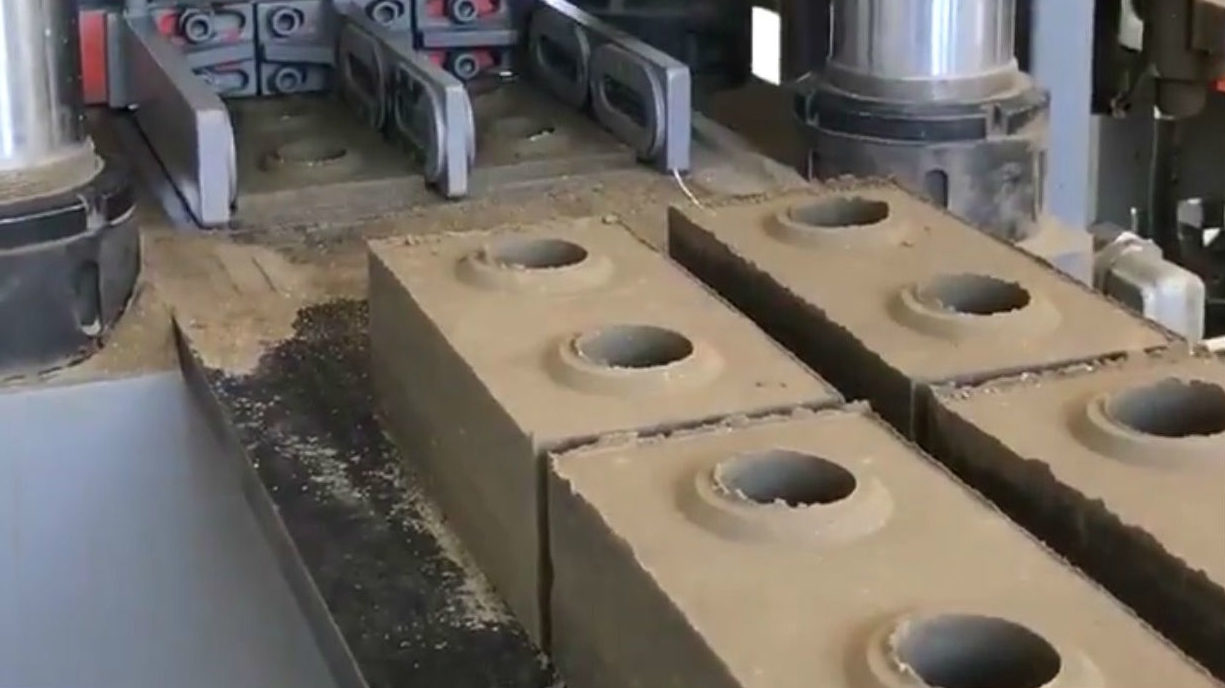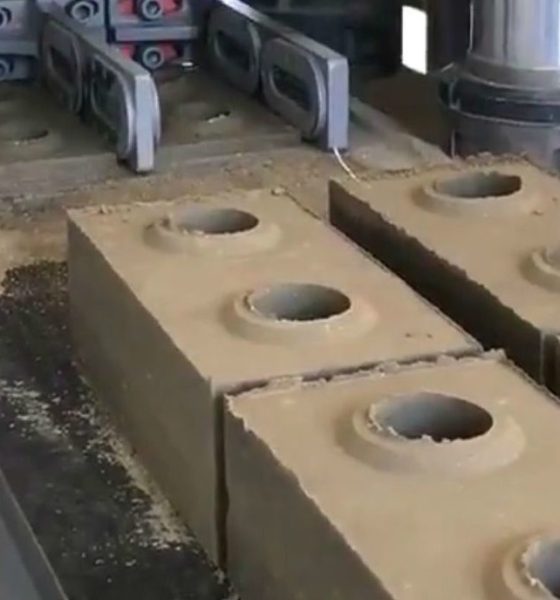

News
Musk’s Boring Company shares glimpse of Boring Bricks being produced
Just a bit over a week since teasing an image of a gantry that would be utilized for the downtown Chicago-O’Hare high-speed transit line, Elon Musk’s tunneling startup, The Boring Company, has uploaded a clip of its Boring Bricks being manufactured.
The short video of the Boring Bricks being produced showcases the unique characteristics of the bricks themselves, such as its slots that enable seamless interlocking. The recently-uploaded clip, while very brief, does give the impression that the production of the earth-made bricks is well underway.
Bricks! pic.twitter.com/6fNROJ86sN
— The Boring Company (@boringcompany) July 13, 2018
The Boring Company’s bricks were initially announced by Elon Musk back in March, when he stated that the new “merch” would be coming soon. The company had only finished selling its Not-a-Flamethrowers by this time, and Musk’s massive Twitter following was eager to see what product the tunneling startup would offer next. According to Musk when he announced the earth bricks, the Boring Bricks would be used to create models of sculptures and buildings. Considering that the blocks would be made from tunneling rock from the Boring Co’s projects, the products would also be rated for California seismic loads, making them incredibly durable.
While Musk at first noted that the bricks would be used to create garden-scale earth replicas of famous landmarks and buildings, it did not take long before one of the Tesla and SpaceX CEO’s followers on Twitter asked if the bricks could be used for low-cost housing projects. Musk promptly stated that the interlocking bricks would feature a surface finish, which would enable people to “build the outer walls of a small house in a day or so.”
By May, Musk reiterated his intentions to use the Boring Company’s bricks as material for affordable housing, and during the tunneling startup’s information session at the Leo Baeck Temple in Los Angeles, the interlocking earth bricks were revealed to the public. A sample of the Boring Brick was also used as a platform for Gary the Snail’s home, the Boring Company’s pet-slash-mascot-of-sorts, during the information session. Musk’s presentation further revealed images of the bricks being used as materials for a wall, as well as an Egyptian-themed model kit.
Apart from serving as materials for low-cost housing and model kits, the Boring Company is also looking at using the bricks for its tunnels. This particular idea has been outlined by the company in its FAQ for months, even before Musk announced the blocks on Twitter.
“The Boring Company is investigating technologies that will recycle the earth into useful bricks to be used to build structures. This is not a new concept, as buildings have been constructed from Earth for thousands of years including, according to recent evidence, the Pyramids. These bricks can potentially be used as a portion of the tunnel lining itself, which is typically built from concrete.”
The Boring Company recently won a high-profile contract to build a high-speed transport line connecting downtown Chicago to O’Hare airport. The project, which Musk expects will cost ~$1 billion, is expected to break ground within the next few months. The preparations for the transit line are already underway, with Chicago Mayor Rahm Emanuel recently traveling to the headquarters of the Department of Transportation in Washington, in order to discuss the upcoming project with DOT officials.

Elon Musk
Elon Musk’s X will start using a Tesla-like software update strategy
The initiative seems designed to accelerate updates to the social media platform, while maintaining maximum transparency.

Elon Musk’s social media platform X will adopt a Tesla-esque approach to software updates for its algorithm.
The initiative seems designed to accelerate updates to the social media platform, while maintaining maximum transparency.
X’s updates to its updates
As per Musk in a post on X, the social media company will be making a new algorithm to determine what organic and advertising posts are recommended to users. These updates would then be repeated every four weeks.
“We will make the new 𝕏 algorithm, including all code used to determine what organic and advertising posts are recommended to users, open source in 7 days. This will be repeated every 4 weeks, with comprehensive developer notes, to help you understand what changed,” Musk wrote in his post.
The initiative somewhat mirrors Tesla’s over-the-air update model, where vehicle software is regularly refined and pushed to users with detailed release notes. This should allow users to better understand the details of X’s every update and foster a healthy feedback loop for the social media platform.
xAI and X
X, formerly Twitter, has been acquired by Elon Musk’s artificial intelligence startup, xAI last year. Since then, xAI has seen a rapid rise in valuation. Following the company’s the company’s upsized $20 billion Series E funding round, estimates now suggest that xAI is worth tens about $230 to $235 billion. That’s several times larger than Tesla when Elon Musk received his controversial 2018 CEO Performance Award.
As per xAI, the Series E funding round attracted a diverse group of investors, including Valor Equity Partners, Stepstone Group, Fidelity Management & Research Company, Qatar Investment Authority, MGX, and Baron Capital Group, among others. Strategic partners NVIDIA and Cisco Investments also continued support for building the world’s largest GPU clusters.
News
Tesla FSD Supervised wins MotorTrend’s Best Driver Assistance Award
The decision marks a notable reversal for the publication from prior years, with judges citing major real-world improvements that pushed Tesla’s latest FSD software ahead of every competing ADAS system.

Tesla’s Full Self-Driving (Supervised) system has been named the best driver-assistance technology on the market, earning top honors at the 2026 MotorTrend Best Tech Awards.
The decision marks a notable reversal for the publication from prior years, with judges citing major real-world improvements that pushed Tesla’s latest FSD software ahead of every competing ADAS system. And it wasn’t even close.
MotorTrend reverses course
MotorTrend awarded Tesla FSD (Supervised) its 2026 Best Tech Driver Assistance title after extensive testing of the latest v14 software. The publication acknowledged that it had previously criticized earlier versions of FSD for erratic behavior and near-miss incidents, ultimately favoring rivals such as GM’s Super Cruise in earlier evaluations.
According to MotorTrend, the newest iteration of FSD resolved many of those shortcomings. Testers said v14 showed far smoother behavior in complex urban scenarios, including unprotected left turns, traffic circles, emergency vehicles, and dense city streets. While the system still requires constant driver supervision, judges concluded that no other advanced driver-assistance system currently matches its breadth of capability.
Unlike rival systems that rely on combinations of cameras, radar, lidar, and mapped highways, Tesla’s FSD operates using a camera-only approach and is capable of driving on city streets, rural roads, and freeways. MotorTrend stated that pure utility, the ability to handle nearly all road types, ultimately separated FSD from competitors like Ford BlueCruise, GM Super Cruise, and BMW’s Highway Assistant.
High cost and high capability
MotorTrend also addressed FSD’s pricing, which remains significantly higher than rival systems. Tesla currently charges $8,000 for a one-time purchase or $99 per month for a subscription, compared with far lower upfront and subscription costs from other automakers. The publication noted that the premium is justified given FSD’s unmatched scope and continuous software evolution.
Safety remained a central focus of the evaluation. While testers reported collision-free operation over thousands of miles, they noted ongoing concerns around FSD’s configurable driving modes, including options that allow aggressive driving and speeds beyond posted limits. MotorTrend emphasized that, like all Level 2 systems, FSD still depends on a fully attentive human driver at all times.
Despite those caveats, the publication concluded that Tesla’s rapid software progress fundamentally reshaped the competitive landscape. For drivers seeking the most capable hands-on driver-assistance system available today, MotorTrend concluded Tesla FSD (Supervised) now stands alone at the top.
News
Elon Musk’s Grokipedia surges to 5.6M articles, almost 79% of English Wikipedia
The explosive growth marks a major milestone for the AI-powered online encyclopedia, which was launched by Elon Musk’s xAI just months ago.

Elon Musk’s Grokipedia has grown to an impressive 5,615,201 articles as of today, closing in on 79% of the English Wikipedia’s current total of 7,119,376 articles.
The explosive growth marks a major milestone for the AI-powered online encyclopedia, which was launched by Elon Musk’s xAI just months ago. Needless to say, it would only be a matter of time before Grokipedia exceeds English Wikipedia in sheer volume.
Grokipedia’s rapid growth
xAI’s vision for Grokipedia emphasizes neutrality, while Grok’s reasoning capabilities allow for fast drafting and fact-checking. When Elon Musk announced the initiative in late September 2025, he noted that Grokipedia would be an improvement to Wikipedia because it would be designed to avoid bias.
At the time, Musk noted that Grokipedia “is a necessary step towards the xAI goal of understanding the Universe.”
Grokipedia was launched in late October, and while xAI was careful to list it only as Version 0.1 at the time, the online encyclopedia immediately earned praise. Wikipedia co-founder Larry Sanger highlighted the project’s innovative approach, noting how it leverages AI to fill knowledge gaps and enable rapid updates. Netizens also observed how Grokipedia tends to present articles in a more objective manner compared to Wikipedia, which is edited by humans.
Elon Musk’s ambitious plans
With 5,615,201 total articles, Grokipedia has now grown to almost 79% of English Wikipedia’s article base. This is incredibly quick, though Grokipedia remains text-only for now. xAI, for its part, has now updated the online encyclopedia’s iteration to v0.2.
Elon Musk has shared bold ideas for Grokipedia, including sending a record of the entire knowledge base to space as part of xAI’s mission to preserve and expand human understanding. At some point, Musk stated that Grokipedia will be renamed to Encyclopedia Galactica, and it will be sent to the cosmos.
“When Grokipedia is good enough (long way to go), we will change the name to Encyclopedia Galactica. It will be an open source distillation of all knowledge, including audio, images and video. Join xAI to help build the sci-fi version of the Library of Alexandria!” Musk wrote, adding in a later post that “Copies will be etched in stone and sent to the Moon, Mars and beyond. This time, it will not be lost.”









